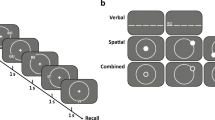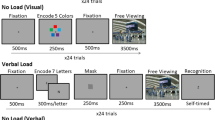Abstract
People fixate on blank spaces if visual stimuli previously occupied these regions of space. This so-called “looking at nothing” (LAN) phenomenon is said to be a part of information retrieval from internal memory representations, but the exact nature of the relationship between LAN and memory retrieval is unclear. While evidence exists for an influence of LAN on memory retrieval for visuospatial stimuli, evidence for verbal information is mixed. Here, we tested the relationship between LAN behavior and memory retrieval in an episodic retrieval task where verbal information was presented auditorily during encoding. When participants were allowed to gaze freely during subsequent memory retrieval, LAN occurred, and it was stronger for correct than for incorrect responses. When eye movements were manipulated during memory retrieval, retrieval performance was higher when participants fixated on the area associated with to-be-retrieved information than when fixating on another area. Our results provide evidence for a functional relationship between LAN and memory retrieval that extends to verbal information.


Similar content being viewed by others
References
Allopenna, P. D., Magnuson, J. S., & Tanenhaus, M. K. (1998). Tracking the time course of spoken word recognition using eye movements: Evidence for continuous mapping models. Journal of Memory and Language, 38, 419–439. doi:10.1006/jmla.1997.2558.
Altmann, G. T. M. (2004). Language-mediated eye movements in the absence of a visual world: the “blank screen paradigm”. Cognition, 93, 79–87. doi:10.1016/j.cognition.2004.02.005.
Altmann, G. T. M., & Kamide, Y. (2007). The real-time mediation of visual attention by language and world knowledge: Linking anticipatory (and other) eye movements to linguistic processing. Journal of Memory and Language, 57, 502–518. doi:10.1016/j.jml.2006.12.004.
Altmann, G. T. M., & Kamide, Y. (2009). Discourse-mediation of the mapping between language and the visual world: Eye movements and mental representation. Cognition, 111, 55–71. doi:10.1016/j.cognition.2008.12.005.
Anderson, S. E., & Spivey, M. J. (2009). The enactment of language: decades of interactions between linguistic and motor processes. Language and Cognition, 1, 87–111. doi:10.1515/LANGCOG.2009.005.
Barsalou, L. W. (2008). Grounded cognition. Annual Review of Psychology, 59, 617–645. doi:10.1146/annurev.psych.59.103006.093639.
Barsalou, L. W., Kyle Simmons, W., Barbey, A. K., & Wilson, C. D. (2003). Grounding conceptual knowledge in modality-specific systems. Trends in Cognitive Sciences, 7, 84–91.
Brandt, S. A., & Stark, L. W. (1997). Spontaneous eye movements during visual imagery reflect the content of the visual scene. Journal of Cognitive Neuroscience, 9, 27–38.
Danker, J. F., & Anderson, J. R. (2010). The ghosts of brain states past: remembering reactivates the brain regions engaged during encoding. Psychological Bulletin, 136, 87–102. doi:10.1037/a0017937.
Ferreira, F., Apel, J., & Henderson, J. M. (2008). Taking a new look at looking at nothing. Trends in Cognitive Sciences, 12, 405–410. doi:10.1016/j.tics.2008.07.007.
Foulsham, T., & Kingstone, A. (2013). Fixation-dependent memory for natural scenes: An experimental test of scanpath theory. Journal of Experimental Psychology: General, 142, 41–56. doi:10.1037/a0028227.
Godijn, R., & Theeuwes, J. (2012). Overt is no better than covert when rehearsing visuo-spatial information in working memory. Memory & Cognition, 40, 52–61. doi:10.3758/s13421-011-0132-x.
Grant, E. R., & Spivey, M. J. (2003). Eye movements and problem solving: Guiding attention guides thought. Psychological Science, 14, 462–466.
Holm, L., & Mäntylä, T. (2007). Memory for scenes: Refixations reflect retrieval. Memory & Cognition, 35, 1664–1674.
Hommel, B. (1998). Event files: Evidence for automatic integration of stimulus-response episodes. Visual Cognition, 5, 183–216. doi:10.1080/713756773.
Hommel, B. (2004). Event files: Feature binding in and across perception and action. Trends in Cognitive Sciences, 8, 494–500. doi:10.1016/j.tics.2004.08.007.
Hoover, M. A., & Richardson, D. C. (2008). When facts go down the rabbit hole: Contrasting features and objecthood as indexes to memory. Cognition, 108, 533–542. doi:10.1016/j.cognition.2008.02.011.
Huettig, F., Mishra, R. K., & Olivers, C. N. L. (2012). Mechanisms and representations of language-mediated visual attention. Frontiers in Psychology, 2, 1–11. doi:10.3389/fpsyg.2011.00394.
Huettig, F., Olivers, C. N. L., & Hartsuiker, R. J. (2011). Looking, language, and memory: Bridging research from the visual world and visual search paradigms. Acta Psychologica, 137, 138–150. doi:10.1016/j.actpsy.2010.07.013.
Jahn, G., & Braatz, J. (2014). Memory indexing of sequential symptom processing in diagnostic reasoning. Cognitive Psychology, 68, 59–97. doi:10.1016/j.cogpsych.2013.11.002.
Johansson, R., Holsanova, J., Dewhurst, R., & Holmqvist, K. (2012). Eye movements during scene recollection have a functional role, but they are not reinstatements of those produced during encoding. Journal of Experimental Psychology: Human Perception and Performance, 38, 1289–1314. doi:10.1037/a0026585.
Johansson, R., Holsanova, J., & Holmqvist, K. (2006). Pictures and spoken descriptions elicit similar eye movements during mental imagery, both in light and in complete darkness. Cognitive Science, 30, 1053–1079. doi:10.1207/s15516709cog0000.
Johansson, R., & Johansson, M. (2014). Look here, eye movements play a functional role in memory retrieval. Psychological Science, 25, 236–242. doi:10.1177/0956797613498260.
Kent, C., & Lamberts, K. (2008). The encoding-retrieval relationship: Retrieval as mental simulation. Trends in Cognitive Sciences, 12, 92–98. doi:10.1016/j.tics.2007.12.004.
Laeng, B., Bloem, I. M., D’Ascenzo, S., & Tommasi, L. (2014). Scrutinizing visual images: The role of gaze in mental imagery and memory. Cognition, 131, 263–283. doi:10.1016/j.cognition.2014.01.003.
Laeng, B., & Teodorescu, D. (2002). Eye scanpaths during visual imagery reenact those of perception of the same visual scene. Cognitive Science, 26, 207–231. doi:10.1207/s15516709cog2602.
Mäntylä, T., & Holm, L. (2006). Gaze control and recollective experience in face recognition. Visual Cognition, 14, 365–386. doi:10.1080/13506280500347992.
Martarelli, C. S., & Mast, F. W. (2010). Preschool children’s eye-movements during pictorial recall. The British Journal of Developmental Psychology, 29, 425–436. doi:10.1348/026151010X495844.
Martarelli, C. S., & Mast, F. W. (2013). Eye movements during long-term pictorial recall. Psychological Research, 77, 303–309. doi:10.1007/s00426-012-0439-7.
Mast, F. W., & Kosslyn, S. M. (2002). Eye movements during visual mental imagery. Trends in Cognitive Sciences, 6, 271–272.
Mayberry, M. R., Crocker, M. W., & Knoeferle, P. (2009). Learning to attend: a connectionist model of situated language comprehension. Cognitive Science, 33, 449–496. doi:10.1111/j.1551-6709.2009.01019.x.
Morris, C. D., Bransford, J. D., & Franks, J. J. (1977). Levels of processing versus transfer appropriate processing. Journal of Verbal Learning and Verbal Behavior, 16, 519–533. doi:10.1016/S0022-5371(77)80016-9.
Mulckhuyse, M., & Theeuwes, J. (2010). Unconscious attentional orienting to exogenous cues: A review of the literature. Acta Psychologica, 134, 299–309. doi:10.1016/j.actpsy.2010.03.002.
Neisser, U. (1976). Cognition and reality: Principles and implications of cognitive psychology. San Francisco, CA: WH Freeman.
Platzer, C., Bröder, A., & Heck, D. W. (2014). Deciding with the eye: How the visually manipulated accessibility of information in memory influences decision behavior. Memory & Cognition, 42, 595–608. doi:10.3758/s13421-013-0380-z.
Postle, B. R., Idzikowski, C., Sala, S. Della, Logie, R. H., & Baddeley, A. D. (2006). The selective disruption of spatial working memory by eye movements. Quarterly Journal of Experimental Psychology, 59, 100–120. doi:10.1080/17470210500151410.
Pylyshyn, Z. W. (2001). Visual indexes, preconceptual objects, and situated vision. Cognition, 80, 127–158.
Rayner, K. (2009). Eye movements and attention in reading, scene perception, and visual search. Quarterly Journal of Experimental Psychology, 62, 1457–1506. doi:10.1080/17470210902816461.
Renkewitz, F., & Jahn, G. (2012). Memory Indexing: A novel method for tracing memory processes in complex cognitive tasks. Journal of Experimental Psychology. Learning, Memory, and Cognition, 38, 1622–1639. doi:10.1037/a0028073.
Richardson, D. C., Altmann, G. T. M., Spivey, M. J., & Hoover, M. A. (2009). Much ado about eye movements to nothing: A response to Ferreira et al.: Taking a new look at looking at nothing. Trends in Cognitive Sciences, 13, 235–236. doi:10.1016/j.tics.2009.02.006.
Richardson, D. C., & Kirkham, N. Z. (2004). Multimodal events and moving locations: eye movements of adults and 6-month-olds reveal dynamic spatial indexing. Journal of Experimental Psychology: General, 133, 46–62. doi:10.1037/0096-3445.133.1.46.
Richardson, D. C., & Spivey, M. J. (2000). Representation, space and Hollywood Squares: Looking at things that aren’t there anymore. Cognition, 76, 269–295. doi:10.1016/S0010-0277(00)00084-6.
Rosenthal, R., Rosnow, R. L., & Rubin, D. B. (2000). Contrasts and effect sizes in behavioral research: A correlational approach. New York, NY: Cambridge University Press.
Rugg, M. D., Johnson, J. D., Park, H., & Uncapher, M. R. (2008). Encoding-retrieval overlap in human episodic memory: A functional neuroimaging perspective. Progress in Brain Research, 169, 339–352. doi:10.1016/S0079-6123(07)00021-0.
Rugg, M. D., & Wilding, E. (2000). Retrieval processing and episodic memory. Trends in Cognitive Sciences, 4, 108–115.
Scholz, A., von Helversen, B., & Rieskamp, J. (2015). Eye movements reveal memory processes during similarity-and rule-based decision making. Cognition, 136, 228–246. doi:10.1016/j.cognition.2014.11.019.
Spivey, M. J. (2007). The Continuity of Mind. New York, NY: Oxford University Press.
Spivey, M. J., & Dale, R. (2011). Eye movements both reveal and influence problem solving. In S. P. Liversedge, I. D. Gilchrist, & S. Everling (Eds.), The Oxford handbook of eye movements (pp. 551–562). Oxford: Oxford University Press.
Spivey, M. J., & Geng, J. J. (2001). Oculomotor mechanisms activated by imagery and memory: Eye movements to absent objects. Psychological Research, 65, 235–241. doi:10.1007/s004260100059.
Tanenhaus, M. K., Spivey-Knowlton, M. J., Eberhard, K. M., & Sedivy, J. C. (1995). Integration of visual and linguistic information in spoken language comprehension. Science, 268, 1632–1634.
Theeuwes, J. (2010). Top-down and bottom-up control of visual selection. Acta Psychologica, 135(2), 77–99. doi:10.1016/j.actpsy.2010.02.006.
Theeuwes, J., Belopolsky, A. V., & Olivers, C. N. L. (2009). Interactions between working memory, attention and eye movements. Acta Psychologica, 132, 106–114. doi:10.1016/j.actpsy.2009.01.005.
Thomas, L. E., & Lleras, A. (2009). Covert shifts of attention function as an implicit aid to insight. Cognition, 111, 168–174. doi:10.1016/j.cognition.2009.01.005.
Tulving, E. (1983). Elements of episodic memory. Oxford, England: Clarendon Press.
Tulving, E., & Thomson, D. M. (1973). Encoding specificity and retrieval processes in episodic memory. Psychological Review, 80, 352–373.
Wilson, M. (2002). Six views of embodied cognition. Psychonomic Bulletin & Review, 9, 625–636.
Yantis, S., & Jonides, J. (1981). Abrupt visual onsets and selective attention: Evidence from visual search. Journal of Experimental Psychology: Human Perception and Performance, 7, 937–947.
Acknowledgments
The authors would like to thank Claudia Dietzel and Lars Eberspach for collecting the data that was reported here, Denise Schneider for recording auditory materials and Anja Prittmann for helpful comments.
Author information
Authors and Affiliations
Corresponding author
Rights and permissions
About this article
Cite this article
Scholz, A., Mehlhorn, K. & Krems, J.F. Listen up, eye movements play a role in verbal memory retrieval. Psychological Research 80, 149–158 (2016). https://doi.org/10.1007/s00426-014-0639-4
Received:
Accepted:
Published:
Issue Date:
DOI: https://doi.org/10.1007/s00426-014-0639-4




